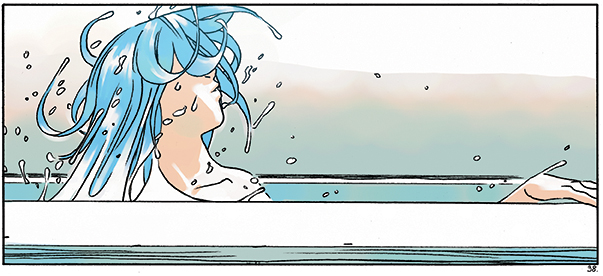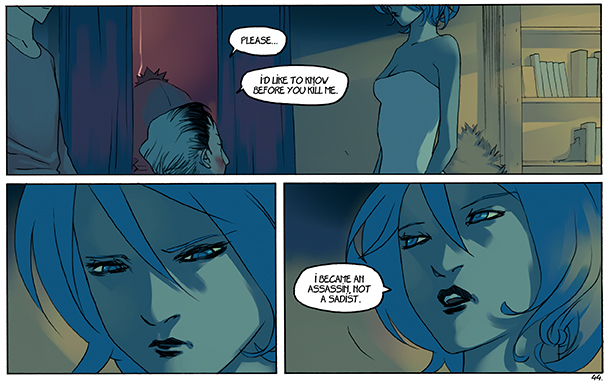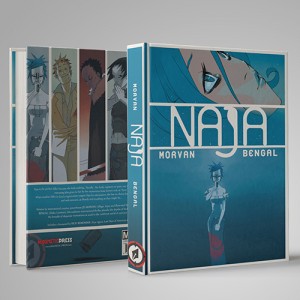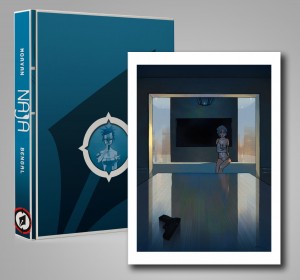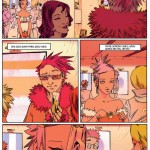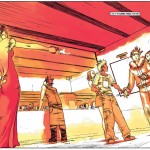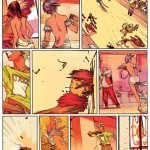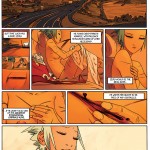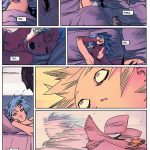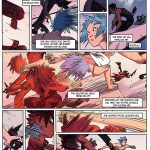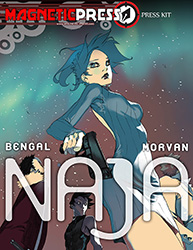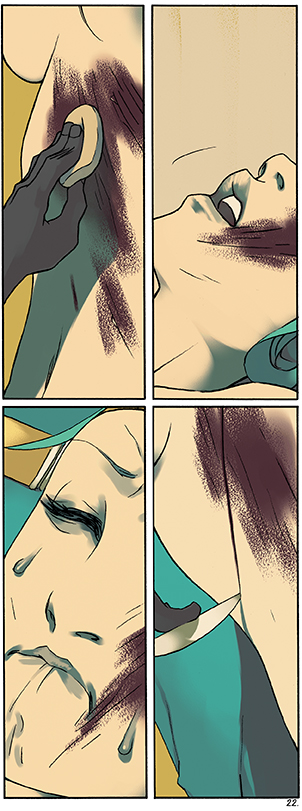NAJA is a taught, action-packed thriller set in countries spanning the globe. What inspired you to this project?
JD MORVAN: Well, it’s the journey itself that inspired NAJA. I was traveling in the car and I had this idea: “When the number 1 killer of a criminal organization takes a contract out on the number 3 killer, what does number 2 do?” I texted the idea to Bengal, and during the rest of that trip we invented Naja. On arrival, we had the concept of the entire series. I know, it wasn’t very safe because I was driving, but Inspiration arrives when she wants…
BENGAL: It was JD’s idea, every new setting where the action takes place allows us to bring a new analysis on a category of people, and a new opportunity for Naja to despise something. The repeating aspect of it, without making it an actual running gag, makes it quite funny for me: there’s really no way to please her!
The narration carries the reader through the story, with an abundance of psychoanalysis and political commentary. What was the intention behind keeping the narrator’s identity mysterious (until the end)? And what were the challenges keeping that mystery without revealing the identity through the commentary?
BENGAL: Well, the most obvious challenge, I reckon, was to make sure it was impossible to know who the narrator could be, while giving several hints it was someone close to Naja. The mystery behind it was important, in my opinion, to keep in the reader’s mind that there was someone above all the players, someone possibly almighty, someone seeing it all… which, in a way, adds an oppressive ambiance to the story sometimes. I personally thought, since the beginning, that the voice over was one of the key element to Naja’s story.
JD MORVAN: As for the voice-over, that was going to be a surprise, because I myself did not know who it was. In my head, it changed during the series to several different characters. Thus who, I did not know, but why, that I knew. I wanted to write a story like (Milan) Kundera, in that it is told by a narrator who knew the characters’ psychology better than the characters themselves. An omniscient narrator, capable of explaining psychologically the actions that seem natural to the characters.
The book has a very unique visual style – slightly loose, but carefully framed with very expressive details and dynamics. Some would say it has an anime/manga flavor, while others describe it as uniquely European. How was the look and visual direction of NAJA inspired?
BENGAL: I decided from the get-go that I would mostly work the narration, the energy, the angles, all the storytelling details that would make the reading as fluid as I could, moreso than the actual graphics. The documentation as well – with all those countries Naja visits (and not me, sadly), I tried to give as much ambiance as there were locations. I realize now that I’ve probably been too lazy on the drawing sometimes; the intention was to keep the reading as swift and energetic as it could be, but looking back, I would redraw a lot of things. Having said that, I truly believe any lack in the drawing department doesn’t damage the reader’s experience at all, as the story really flows as it is, in my opinion. At least, I hope so!
JD MORVAN: As for the character and her coolness, I was inspired by an illustration Bengal made of a young woman smoking on a sofa. Everything grew from that paleness and her lost look.
You have created numerous popular and successful titles in France; why do you think NAJA has proven to be so popular among fans worldwide? Do you think this US debut will open a gateway to more of your work appealing to North American and English-speaking fans?
JD MORVAN: Naja is a comic built on trust. Between Bengal and me, of course, but also in ourselves. Because the story moved forward as things grew from the concept, without having a predefined outline. There is some danger in this way of working, and Bengal had the balls to let me surprise us permanently. It was the best way for us to surprise the reader with a plot-thread that could have been the basis for an American B-movie. We think we made a success with something different.
What is interesting in Naja, is that it takes place all over the world but not in the USA. Fortunately, because of that, Naja never says why she hates Americans! Haha. Maybe with a little luck it will allow us to work directly for the American market, that perhaps misses me a little since writing Wolverine: Saudade. And Bengal has dreamed of drawing Superman for a long time…
BENGAL: It’s our biggest story so far, and I also believe it benefits from the roots JD and I have together in the industry — we’ve known each other for a long time now and so far he’s the only writer I’ve worked with! JD’s work is tailored for my style, and he knows exactly how to rely on my storytelling. We are in a comfort zone when we make a book together.
I deeply hope we will bring something enjoyable enough to readers, and we would love to keep working for the US market – it’s actually what we’re aiming at lately!


